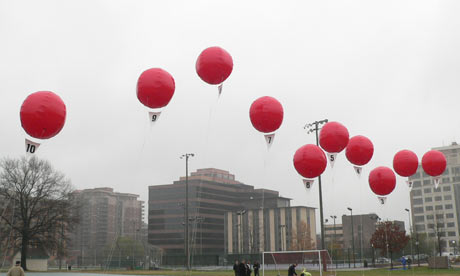-
guardian.co.uk,
Friday 4 December 2009 08.13 GMT
- Article history

For most of us, social networking
sites are just for fun - checking what our friends are doing,
organising our weekends or playing games when the boss is not looking.
But the stakes for users of sites like Facebook and Twitter are set to
increase dramatically tomorrow, as the US government launches a
competition that offers cunning web users the chance to win thousands
of dollars.
In a nine-day challenge run by Darpa, the US Defence
Advanced Research Projects Agency, members of the public are being
offered a grand prize of $40,000 if they successfully use the internet and social networks to track down a series of balloons hidden across America.
Under the rules of the competition, known as the Darpa Network Challenge, 10 large red balloons will be launched simultaneously at secret location across the United States
tomorrow. Players have until December 14 to find out where they were
located, and the first person - or group of people - to track them all
down will scoop the jackpot, the equivalent of more than £24,000.
The
rules are relatively loose: the balloons, which each measure eight feet
in diameter, will be placed at fixed locations that are easily
accessible and visible from nearby roads but will only be visible for
one day. More than 300 teams have already signed up to take part and
officials expect a number - from offering a reward online to sifting
through various social networking sites to scan for sightings of the
balloons.
"The most innovative ideas we probably haven't heard
about yet, because there is an incentive to keep them secret," said
Peter Lee, director of the agency's transformational convergence
technology office.
On the surface, the premise seems a little
wacky for a government agency that uses its annual budget of more than
$3bn to create technology for use by the US military. After all, the
organisation, has helped fund technological breakthroughs such as the
internet and unmanned aerial vehicles in its different incarnations
over the years.
But despite the whimsical nature of the task, Darpa officials say they are not running the challenge for fun.
According
to the event's organisers, the challenge is an attempt to find out more
about how large-scale problems can be solved by using the net and
social networks to enhance "timely communication, wide-area team
building and urgent mobilisation".
The idea is that through
observing how the various groups attempting the task fare, the
organisation will learn a significant amount about the way computer
systems and popular websites can be used to harness collective
intelligence.
"We are not interested in the balloons - we already
know where those are," said the group's deputy director, Norman
Whitaker. "It's the techniques people use to solve the challenge we're
focused on."
It is not the first time Darpa has taken an offbeat
approach to its research for the Pentagon. In recent years, the agency
has run a number of other competitions open to the public, including a series of races pitting computer-controlled driverless cars against each other.
The
latest challenge has already attracted a wide spread of interest from
academics and computer scientists, as well as from some more unexpected
quarters.
Record-breaking balloon artist Larry Moss has said
that he will also be attempting to locate the targets. Moss, who is
based in Rochester, New York, says that if he wins the top prize, he
will spend his winnings making a special tribute balloon in the shape
of a giant flying cupcake.
"It's a logical extension of my plans," he said.
Source
http://www.guardian.co.uk/technology/2009/dec/04/darpa-balloon-challenge













